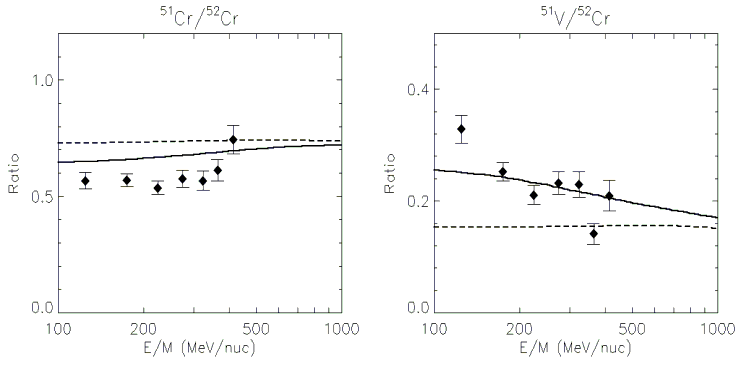
| ACE News Archives | ACE News #47, 18 July 2000 |
ACE News Archives |

The isotopes 37Ar, 44Ti, 49V, 51Cr, 55Fe, and 57Co are unstable with halflives that are very short (<102 yr) compared with the time between nucleosynthesis and acceleration of the primary cosmic rays (>105 yr; see ACE News #17) and compared with the confinement time of cosmic rays in the Galaxy (>107 yr). Nonetheless, these isotopes, which can only decay by capturing an orbital electron, are observed in the cosmic rays because they are produced as bare nuclei from fragmentation of heavier cosmic-rays that collide with atoms of the interstellar gas. These electron-capture nuclei can, however, subsequently decay if they pick up an orbital electron from the interstellar gas. There is a high probability of electron attachment (and subsequent nuclear decay) during the galactic lifetime of one of these nuclei at energies below a few hundred MeV/nucleon and a relatively low probability of electron attachment at higher energies.
The Cosmic Ray Isotope Spectrometer (CRIS) has made the first observations of the energy dependence of the abundances of these electron-capture isotopes. The figures show CRIS measurements for the isotopes involved in the 51Cr --> 51V decay, normalized to the abundance of the stable secondary isotope 52Cr. If electron-capture decay has occurred, one should expect a depletion of 51Cr and an enhancement of 51V at the lower energies. The 51Cr data are consistent with a depletion at the lower end of the 100 - 500 MeV/nucleon energy range (corresponding to interstellar energies ~300 - 800 MeV/nucleon due to solar modulation). The 51V is correspondingly enhanced at the lower energies. These data agree more closely with a cosmic-ray propagation model that includes the effects of electron attachment (solid line) than with one that neglects these effects (dashed line). The CRIS observations, particularly for 51V, indicate that electron attachment and decay can introduce a significant energy dependence in the abundances of electron-capture nuclides relative to their stable counterparts.
With additional modeling it should be possible to use this energy dependence as a probe of processes which may have altered cosmic-ray energies after electron-capture decays occurred. One interesting possibility is to search for indications that cosmic rays may have experienced reacceleration by passing supernova shocks in the interstellar medium.
Contributed by Susan Niebur of Washington University in St. Louis.
For more information about the instruments on ACE see /ACE/.
Last modified 17 July 2000, by Steve Sears